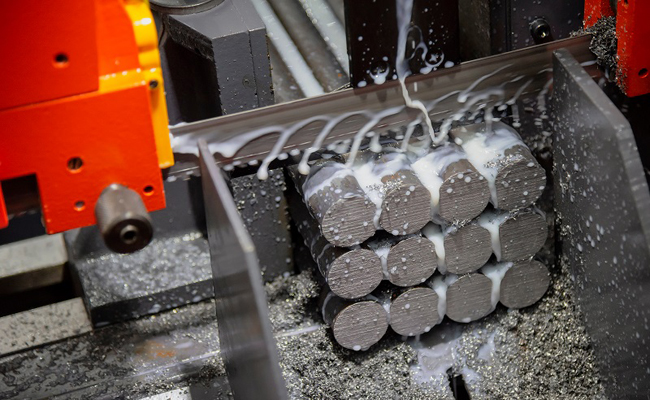CH-360HA Automatic Band Sawing Machine
Cutting Capacity :
When cutting stainless steel with a metal band saw, adjustments must be made to account for its high toughness, work hardening tendency, chip adhesion, and poor heat dissipation. Below are the key operational guidelines:

1. Blade Selection
Material: Use wear-resistant bimetal blades (e.g., M42 cobalt teeth) or blades specifically designed for stainless steel to resist adhesion.
Tooth Geometry:
Large rake angle (10°–15°) reduces cutting resistance and prevents chip buildup.
Variable pitch (e.g., 3/4 TPI) minimizes vibration and chip clogging.
Tooth Count:
For material <50mm thick, use 3 TPI.
For thicker sections, use 2/3 TPI to ensure proper chip clearance.
2. Cutting Parameters
Cutting Speed: Maintain 25–35 m/min (never exceed 40 m/min) to avoid hardening.
Feed Pressure: Increase by 20%–30% compared to carbon steel, but apply steadily to avoid sudden load spikes.
Cooling & Lubrication:
Cutting Fluid: Use high-lubricity fluid (with extreme-pressure additives) for stainless steel, applied continuously.
Wire Brush: Use a synchronized brush to clear chips and prevent re-cutting.
3. Operational Techniques
Secure Clamping: Prevent vibration-induced blade wear, especially for thin-walled tubes (use backing supports).
Cut Surface Check: If the cut surface becomes shiny (work-hardened), reduce speed and inspect blade wear.
Step Cutting: For thick materials (>100mm), pause periodically to clear chips and cool the workpiece.
4. Maintenance & Safety
Blade Life: Blades wear faster when cutting stainless steel—monitor sharpness and replace as needed.
Machine Check: Ensure the band saw’s guide arms and hydraulic system are stable to avoid pressure fluctuations.
Troubleshooting
Chip Adhesion: Increase cutting fluid flow or switch to a non-stick coated blade.
Cut Deviation: Adjust blade tension (300–350 N/mm²) and check guide alignment.
Blade Breakage: Check for sudden feed pressure changes or pre-existing blade damage.
By optimizing blade selection, parameters, and techniques, a metal band saw can efficiently cut stainless steel while extending tool life. For special grades (e.g., titanium-stabilized 321 or high-hardness 440C), further reduce speed and use specialized blades.
Cutting Capacity :
Cutting Capacity :